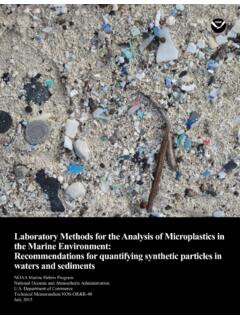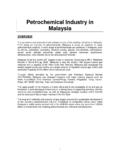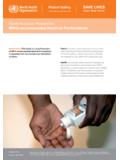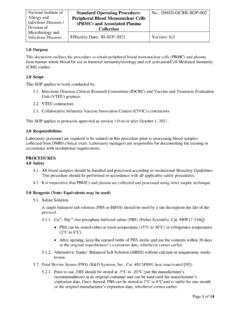Transcription of ENVIRONMENTAL GUIDELINES AND STANDARDS
1 ENVIRONMENTAL GUIDELINES AND STANDARDS . FOR THE petroleum INDUSTRY IN NIGERIA. (EGASPIN). ISSUED BY. THE DEPARTMENT OF petroleum RESOURCES. LAGOS. 1991. REVISED EDITION 2002. COPYRIGHT: This document is the property of the Department of petroleum Resources, and the copyright therein is vested in Department of petroleum Resources, Nigeria. All rights reserved. Neither the whole nor any part of this document may be reproduced, stored in retrieval system, or transmitted in any form by any means (electronic, mechanical, reprographic recording or otherwise) without prior written consent of the copyright owner. FOREWORD. As one of its statutory functions, the Department of petroleum Resources is required to ensure that petroleum industry operators do not degrade the environment in the course of their operations.
2 To effectively carry out these regulatory activities, the Department has been developing ENVIRONMENTAL GUIDELINES and STANDARDS since 1981. These cover the control of the pollutants from the various petroleum exploration, production and processing operations. This publication is an update of these, GUIDELINES and STANDARDS in light of the advancements in the current treatment and pollution control technology. It covers ENVIRONMENTAL control of various petroleum activities in Nigeria, including exploration, production, terminal operations, hydrocarbon processing plants, oil and gas transportation and marketing. It includes where applicable, a discussion of the sources and characteristics of gaseous, liquid and solid wastes generated, principal control methods and effluent limitation and STANDARDS .
3 It is the intention of the Department of petroleum Resources to update this publication periodically as new knowledge becomes available PROFESSOR JUBRIL AMINU. HONOURABLE MINISTER OF petroleum RESOURCES. ii TABLE OF CONTENTS. Title i Foreword ii Table of Contents iii List of Tables vi Part I Introduction 1. Part II Exploration and development operations 3. A. Background 3. B. Description of operations 3. C. Sources and characteristics of waste 4. D. Treatment and control of wastes 6. E. ENVIRONMENTAL management 10. F. Bibliography 27. Appendix II-1 Use of oil based mud systems and the conditions for the discharge of oil contaminated cuttings resulting from drilling operations in Nigeria 28. Appendix II-2 Generic drilling fluids list 31. Appendix II-3 The procedures for the sampling and analysis of drilling cuttings to determine oil content 33.
4 Appendix II-4 General GUIDELINES for ecological sea bed survey sampling and analysis 38. Appendix II-5(A) DPR monthly ENVIRONMENTAL seismic report 41. Appendix II-5(B) Misfired shots 42. Appendix II-6 Stuck radioactive tools abandonment report 43. Part III Production operations 44. A. Background 44. B. Description of operations 44. C. Sources and characteristics of wastes 45. D. Treatment and control of wastes 46. E ENVIRONMENTAL management 47. F Bibliography 60. Part IV Terminal operations 61. A. Background 61. B. Description of operations 61. C. Sources and characteristics of wastes 61. D. Treatment and control of wastes 63. E. ENVIRONMENTAL management 64. F. Bibliography 70. Part V Hydrocarbon processing operations 71. A. petroleum refining 71. B. LPG/natural gas/LNG/gas conversion and processing plants 90.
5 C. Blending plants 100. Appendix V-1 Limits for substances and characteristics affecting the acceptability of water for domestic use (WHO STANDARDS ) 109. iii Part VI Oil and gas transportation 110. A. Background 110. B. Description of operations 110. C. Sources and characteristics of wastes 111. D. Treatment and control of wastes 112. E. ENVIRONMENTAL management 114. Part VII Marketing operations 120. A. Depots 120. B. Retail outlets 125. Part VIII Standardization of ENVIRONMENTAL abatement procedures 132. A. ENVIRONMENTAL impact assessment process 132. B. Contingency planning for the prevention, control and combating of oil and hazardous substances spills 145. Appendix VIII-B1 GUIDELINES for the stocking and listing of response equipment and materials 156. Appendix VIII-B2 Form A Oil spillage/Leakage notification report 158.
6 Form B Oil spillage/Leakage report 159. Form C Oil spillage response/clean-up report 161. Appendix VIII-B3 Oil chemical spill and contamination clean-up certification form 163. C. Hazardous wastes management 168. Appendix VIII-C1 Material safety 177. Appendix VIII-C2 Waste material data sheet 179. Appendix VIII-C3 Drilling and production waste injection operations 182. Appendix VIII-C4 Testing criteria for re-usable materials 190. Appendix VIII-C5 Waste manifest 191. Appendix VIII-C6 Generator's waste profile sheet 192. D. Standardization of test procedures for monitoring physico-chemical parameters 196. Appendix VIII-D1 recommended test methods for physico-chemical parameter analysis 210. Appendix VIII-D2 Laboratory safety and total loss control (TLC) guideline to be displayed in every laboratory 212.
7 Appendix VIII-D3 Laboratory accident causation analysis 213. Appendix VIII-D4 Chemicals safety and loss control 216. Appendix VIII-D5 Toxicity characteristic leaching procedure test method (TCLP) 217. Appendix VIII-D6 Laboratory accreditations permit application 240. E. Methodologies for biological monitoring of effluents And recipient environment 244. F. Management and remediation of contaminated land 269. Appendix VIII-F2 Risk-based corrective action for contaminated sites 282. iv G. Decommissioning of oil and gas facilities 286. H. ENVIRONMENTAL management system 289. I. ENVIRONMENTAL audits/reviews 292. Part IX Schedule of implementation, permits enforcement powers and sanctions 294. Appendix IX-1 ENVIRONMENTAL permit application for an industrial waste discharge/disposal permit 298.
8 Appendix IX-2 ENVIRONMENTAL permit industrial waste discharge/disposal permit 299. Appendix IX-3 Notification for compliance with permit conditions 300. Appendix IX-4 Notification of revocation of permit to discharge/dispose of industrial waste 301. Appendix IX-5 Certificate of sampling 302. Appendix IX-6 Drilling production waste injection well permit application 303. Part X Definitions and acronyms 305. v LIST OF TABLES. TABLE NOS. DETAILS PAGE. Table II-1 Volume of cuttings produced and muds required in a typical 4045 meters drilling operation. 5. TableII-2 Minimum distance between shot point and radio transmitters 7. Table II-3 Safe distances (meters) against vibration impact resulting from seismic detonations 8. Table II-4 Safe distances for submarine pipeline 8. Table II-5 Limitations on treated liquid component/aqueous layer of wastes from drilling activities from nearshore/inland areas before the disposal into water bodies 14.
9 Table II-6 Limitations on treated sanitary waste waters 15. Table II-7 Testing criteria for reusable materials 21. Table II-8 Monitoring requirements for discharges from well-drilling operations 24. Table III-1 Effluent limitations for inland/nearshore oil and gas installation for oily waste water 51. Table III-2 Monitoring requirements for production operations Table III-3 National air quality GUIDELINES for maximum exposure 57. Table IV-1 Potentials of separation techniques to separate various oil/water system phases 64. Table V-1 Refineries in Nigeria 71. Table V-2 Discharge limitations for treated petroleum refinery (Fuel Oil/. Gasoline/Lube Oil Category) waste water 81. Table V-3 Discharge limitations for treated petrochemical refinery waste (carbon black and polypropylene waste water) 81.
10 Table V-4 Effluent limitations for treated petrochemical (Linear Alkyl Benzene [LAB] waste water) 82. Table V-5 Relationship between Ringlemann number/percent light transmission and smoke density 82. Table V-6 Monitoring requirements for petroleum refining processes effluent discharge 86. Table V-7 Effluent limits for treated waste water and cooling water Blowdown/regeneration water. 95. Table V-8 Effluent limitations for treated wastewater for blending plants. 104. vi Table VI-1 Effluent limitations for pumpstations 116. Table VI-2 Effluent limitations for ocean ballast 117. Table VII-1 Effluent limitations for deports 124. Table VII-2 Crude oil/product contaminations (Assessment data sheet) 131. Table VIII-D1 Preservatives that may be used to retard changes in sample integrity 199.









